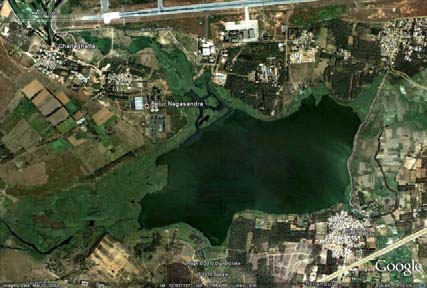Research Papers
Lakes of Mahadevpura constituency of Bengaluru: Current status, changes in distribution and recommendations for restoration - A report by ATREE (2011)
Posted on 02 Mar, 2011 09:18 AM The lakes are now faced with the impacts of rapid urbanization and the Bruhat Bengaluru Mahanagara Palike (BBMP) has been consolidating management of the majority of the city’s lakes under its control in the recent years. The survey dealt with 35 lakes in 10 sub chains in Mahadevpura. The report describes current status, studies changes in extent, and suggests steps for reclamation and conservation.
The lakes are now faced with the impacts of rapid urbanization and the Bruhat Bengaluru Mahanagara Palike (BBMP) has been consolidating management of the majority of the city’s lakes under its control in the recent years. The survey dealt with 35 lakes in 10 sub chains in Mahadevpura. The report describes current status, studies changes in extent, and suggests steps for reclamation and conservation.
Canacona flash floods (2009): Reports submitted by the National Institute of Oceanography to the Government of Goa
Posted on 01 Mar, 2011 09:00 PMThe report is based on a study carried out with the help of National Institute of Oceanography (NIO) and attempts to (1) assemble and analyse available information to describe and identify causes behind the flash floods, and (2) suggest measures to be adopted in Goa to minimise damage arising from similar episodes in future.
Ancient, traditional water and agricultural management systems - A collection of papers from the national seminar on water and culture, organised at Hampi, by Sahayoga and Kannada University (2007)
Posted on 14 Feb, 2011 06:28 AMA National Seminar on Water and Culture was organised by Sahayoga and Kannada University between June 25-27 2007. The seminar was intended to provide useful documentation to those working on water and agricultural management systems, those interested in integrating these traditional techniques with modern practices and to those working towards providing sustainable access to water and food, for all common citizens.
Sethusamudram channel project - An epoch making event - Paper presented at the National Seminar on Water and Culture (2007)
Posted on 14 Feb, 2011 05:24 AMBeginning with the need for a such a shipping lane, the author compares its importance to the Suez and Panama canal. Currently ships have to go round Sri Lanka to go between the two India coasts. This increases the passage time and fuel costs.The canal would lead to a saving of 254 to 424 nautical miles and reduce sailing time of ships by 21 to 36 hours.
Study of ancient water storage systems on forts in Nashik district of Maharashtra - Paper presented at the National Seminar on Water and Culture (2007)
Posted on 14 Feb, 2011 05:11 AMThis paper studies the water supply, distribution, collection and storage in the forts around Nashik with the idea of testing the viability of implementing such systems in areas of similar topography. The history of forts in Maharashtra and the forts around Nashik and the water collection and distribution systems thereof are described.
Two ancient irrigation systems of India - Paper presented at the National Seminar on Water and Culture (2007)
Posted on 14 Feb, 2011 05:03 AMThe Phad system of irrigation, is found in Maharashtra over the rivers Panzara, Girna and Burai, which are tributaries of Tapi.
Water and culture vis-à-vis river diversions - Paper presented at the National Seminar on Water and Culture (2007)
Posted on 14 Feb, 2011 04:48 AMThis paper discusses river linking, as a part of an ancient tradition, and suggests how NGOs can play a role in this attempt. The example of the Koyna dam is taken, and the effective handling of the technical and human angle of the dams construction is detailed through in-depth study and detailed field visits.
Water conservation in the dry regions of India for sustainable agriculture - Paper presented at the National Seminar on Water and Culture (2007)
Posted on 14 Feb, 2011 04:31 AMThis paper attempts to discuss farm water conservation techniques and multiple cropping patterns with the idea of minimising water use. The authors provide a glimpse of agricultural facts that include total geographical area, net sown area etc. They provide population trends in the country to point out to the water and food stress.
Khazana Bawali - Historical wisdom needing protection - Paper presented at the National Seminar on Water and Culture (2007)
Posted on 14 Feb, 2011 03:57 AMThis paper presents the case of Khazana Bawali - a large ancient well that irrigated around 1000 acres in the past but is now in disrepair. The well is about 20 metres in diameter which stores rainwater from the neighbouring hills. The water is brought through underground tunnels that have ventilators at regular intervals to ensure fresh air and also to help in its manual cleaning. This well today irrigates only about 525 acres. It was built by the Jagirdar of Beed in 1582.
Palaeochannels as groundwater storage - A promising option to cope with hydro-hazards in Rajasthan - Paper presented at the National Seminar on Water and Culture (2007)
Posted on 14 Feb, 2011 03:47 AMThis paper discusses the role of paleochannels, which are remnants of stream channels cut in older rocks/sediments and filled by younger overlying sediments, representing the distribution of valley systems, in meeting current and future water requirements.